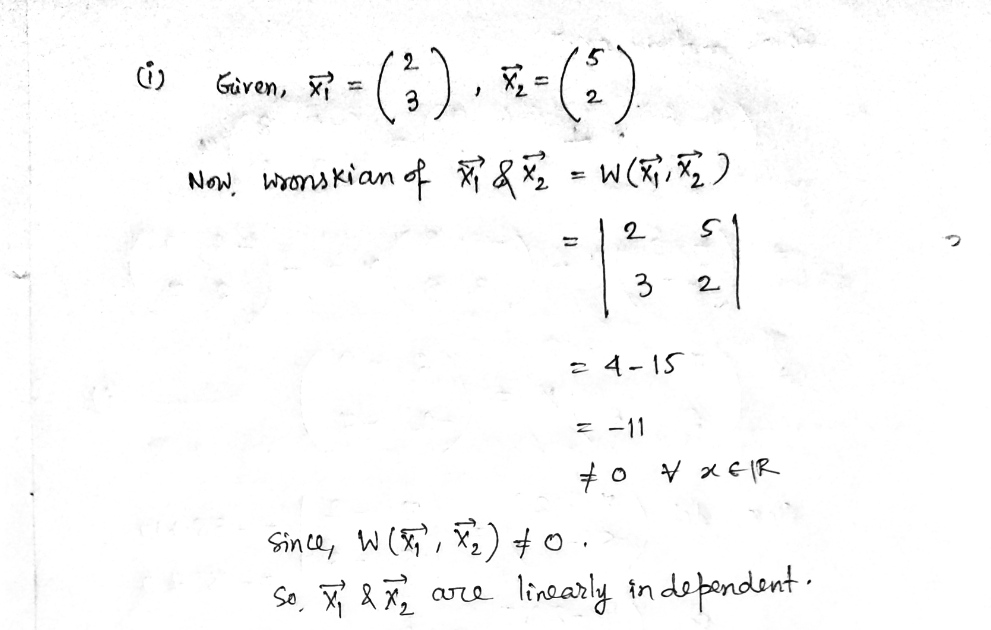D. Use the Wronskian to detcrminc whether or not the vcctors arc independent or not (the answer for both is yes, but show why): ()- ) ) e cos I e sin r i) X1 = 2 and X 3 ii) X = and X, |3D e sin r e cos I
D. Use the Wronskian to detcrminc whether or not the vcctors arc independent or not (the answer for both is yes, but show why): ()- ) ) e cos I e sin r i) X1 = 2 and X 3 ii) X = and X, |3D e sin r e cos I
Advanced Engineering Mathematics
10th Edition
ISBN:9780470458365
Author:Erwin Kreyszig
Publisher:Erwin Kreyszig
Chapter2: Second-order Linear Odes
Section: Chapter Questions
Problem 1RQ
Related questions
Question
100%
![**Topic: Determining Vector Independence Using the Wronskian**
In mathematics, the Wronskian is a determinant used to determine whether a set of solutions to a system of differential equations is linearly independent. This is particularly useful in the study of linear transformations and differential equations. Below, we analyze two problems to determine the linear independence of vectors.
**Problem D**
Use the Wronskian to determine whether or not the vectors are independent. The answer for both cases is yes, but we will show why.
**i)** Consider the vectors:
\[
\vec{X}_1 = \begin{pmatrix} 2 \\ 3 \end{pmatrix} \quad \text{and} \quad \vec{X}_2 = \begin{pmatrix} 5 \\ 2 \end{pmatrix}
\]
**ii)** Consider the vectors:
\[
\vec{X}_1 = \begin{pmatrix} e^x \cos x \\ e^x \sin x \end{pmatrix} \quad \text{and} \quad \vec{X}_2 = \begin{pmatrix} -e^x \sin x \\ e^x \cos x \end{pmatrix}
\]
For each pair of vectors, compute the Wronskian determinant to determine linear independence. If the Wronskian is non-zero, the vectors are linearly independent.](/v2/_next/image?url=https%3A%2F%2Fcontent.bartleby.com%2Fqna-images%2Fquestion%2Fc740e8b2-d410-40ba-b674-1beb1e9bb454%2F8f31943d-d21d-4523-a935-66aa9ec58752%2Fdr4nsjm_processed.jpeg&w=3840&q=75)
Transcribed Image Text:**Topic: Determining Vector Independence Using the Wronskian**
In mathematics, the Wronskian is a determinant used to determine whether a set of solutions to a system of differential equations is linearly independent. This is particularly useful in the study of linear transformations and differential equations. Below, we analyze two problems to determine the linear independence of vectors.
**Problem D**
Use the Wronskian to determine whether or not the vectors are independent. The answer for both cases is yes, but we will show why.
**i)** Consider the vectors:
\[
\vec{X}_1 = \begin{pmatrix} 2 \\ 3 \end{pmatrix} \quad \text{and} \quad \vec{X}_2 = \begin{pmatrix} 5 \\ 2 \end{pmatrix}
\]
**ii)** Consider the vectors:
\[
\vec{X}_1 = \begin{pmatrix} e^x \cos x \\ e^x \sin x \end{pmatrix} \quad \text{and} \quad \vec{X}_2 = \begin{pmatrix} -e^x \sin x \\ e^x \cos x \end{pmatrix}
\]
For each pair of vectors, compute the Wronskian determinant to determine linear independence. If the Wronskian is non-zero, the vectors are linearly independent.
Expert Solution
Solution (1):

Step by step
Solved in 2 steps with 2 images

Recommended textbooks for you

Advanced Engineering Mathematics
Advanced Math
ISBN:
9780470458365
Author:
Erwin Kreyszig
Publisher:
Wiley, John & Sons, Incorporated

Numerical Methods for Engineers
Advanced Math
ISBN:
9780073397924
Author:
Steven C. Chapra Dr., Raymond P. Canale
Publisher:
McGraw-Hill Education

Introductory Mathematics for Engineering Applicat…
Advanced Math
ISBN:
9781118141809
Author:
Nathan Klingbeil
Publisher:
WILEY

Advanced Engineering Mathematics
Advanced Math
ISBN:
9780470458365
Author:
Erwin Kreyszig
Publisher:
Wiley, John & Sons, Incorporated

Numerical Methods for Engineers
Advanced Math
ISBN:
9780073397924
Author:
Steven C. Chapra Dr., Raymond P. Canale
Publisher:
McGraw-Hill Education

Introductory Mathematics for Engineering Applicat…
Advanced Math
ISBN:
9781118141809
Author:
Nathan Klingbeil
Publisher:
WILEY

Mathematics For Machine Technology
Advanced Math
ISBN:
9781337798310
Author:
Peterson, John.
Publisher:
Cengage Learning,

